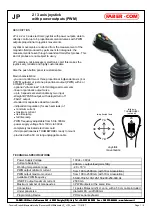
Discharge Air Controller (DAC) Manual
Software Overview • 25
assist in the dehumidification process.
See
for more details.
7.8. 6.10 Reversing Valve
Control
The DAC supports control of a heat or cool
reversing valve. The type of reversing valve can be
selected by the user. The valve may be connected to
any relay output on a DAC designated as a reversing
valve. If the valve is defined as a heating reversing
valve, the relay will energize when heat is active, and
will de-energize when cool is active. The valve will
stay in its current position when the unit goes to idle
mode. Likewise, if the valve is defined as a cooling
reversing valve, the relay will energize only when
cool is active, and will de-energize when heat is
active.
7.9. Standalone Functionality
If for some reason a DAC board loses
communications with its parent E2 unit for longer
than two minutes, the board will go into Standalone
mode.
In Standalone mode, the DAC will continue
Temperature Control as normal using the space
temperature and supply temperature as a control
inputs. The DAC does not have an internal schedule
and will therefore revert to occupied mode while
operating standalone mode.
Dehumidification and Economization will occur
during stand-alone mode only if the board is equipped
with the right local sensors for the strategies selected.
Any control features that rely on communication
with the E2 will not be available. This includes:
• Demand Shed
• Setpoint Reset
• Optimum Start/Stop
• Summer/Winter Setpoints
• Overrides Initiated by E2
7.10. Control Temperature
Sensor Failures
In many cases, the DAC can compensate for
sensor failures by substituting other sensor values.
This allows the DAC to continue operating as close to
normal as possible until the failed sensors can be fixed
or replaced. However, it is important to note that if the
supply temperature sensor fails, the unit will not be
able to turn on any heating or cooling stages. This
sensor must be repaired immediately.
Control Temp Failure
The preferred sensor to be used to control the
space is user configured. By default, Space Temp 1 is
the sensor used. However, Space Temp 2, the average
of both Space Temps, Return Temp, calculated
Apparent Temp or a Zone Temperature from the E2
can be selected as the primary control temperature.
If the preferred sensor fails, a backup sensor will
be selected based on a user configured fallback sensor
selection. If this sensor also fails, the DAC will use
the following priority for selecting a control
temperature:
1. Space Temp 1
2. Space Temp 2
3. Return Temp
4. Zone Temp (sent from E2)
If no valid control temperature is available, a
failure alarm will be generated and sent to the E2
Alarm Advisory Log.
Outside Air Temp Failure
Failure of the outside air temperature sensor
affects Economization only if the DAC is in
standalone mode. In this case, the DAC will disable
the economization strategy until the outside air
temperature sensor is repaired.
Mixed Air Temperature Failure
If the DAC has a modulating outdoor air damper
defined, it will use the mixed air temperature sensor
as its control input for economization (free-cooling).
If the mixed air temperature sensor fails, it will
substitute the supply air temperature sensor as its
control value and continue economization. If neither
the mixed air temperature or supply air temperature
Содержание iPro.Genius
Страница 1: ...Discharge Air Controller DAC Installation and Operational Manual FW Version 1 04F05 026 1727 Rev 3 ...
Страница 2: ......
Страница 3: ...Emerson 1065 Big Shanty Road NW Suite 100 Kennesaw GA 30144 770 425 2724 www emerson com ...
Страница 4: ......
Страница 8: ......
Страница 50: ......
Страница 53: ......
















































